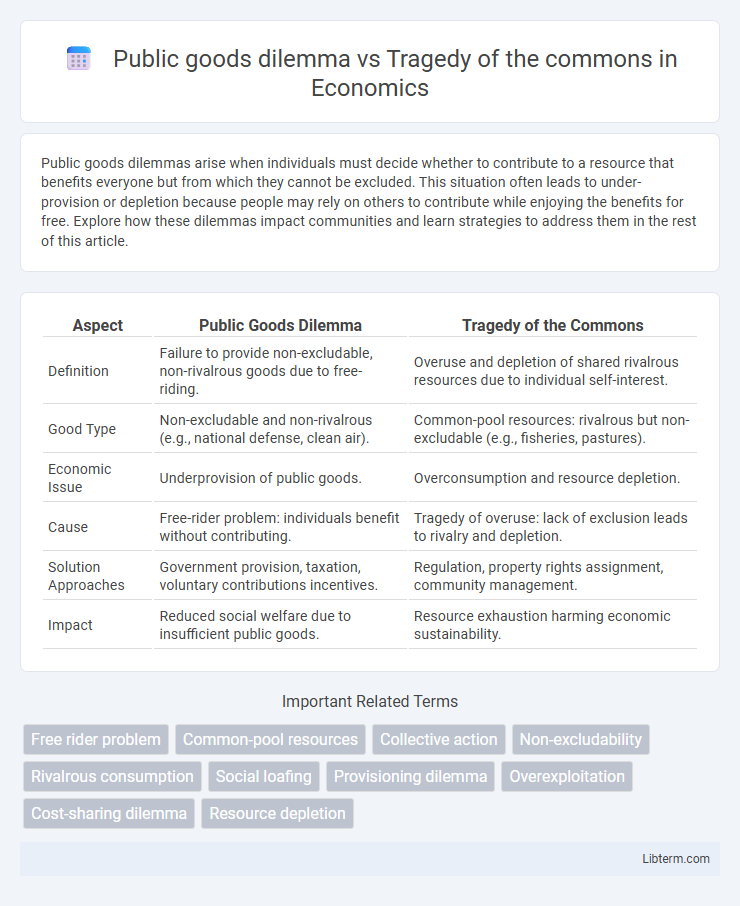Public goods dilemmas arise when individuals must decide whether to contribute to a resource that benefits everyone but from which they cannot be excluded. This situation often leads to under-provision or depletion because people may rely on others to contribute while enjoying the benefits for free. Explore how these dilemmas impact communities and learn strategies to address them in the rest of this article.
Table of Comparison
| Aspect | Public Goods Dilemma | Tragedy of the Commons |
|---|---|---|
| Definition | Failure to provide non-excludable, non-rivalrous goods due to free-riding. | Overuse and depletion of shared rivalrous resources due to individual self-interest. |
| Good Type | Non-excludable and non-rivalrous (e.g., national defense, clean air). | Common-pool resources: rivalrous but non-excludable (e.g., fisheries, pastures). |
| Economic Issue | Underprovision of public goods. | Overconsumption and resource depletion. |
| Cause | Free-rider problem: individuals benefit without contributing. | Tragedy of overuse: lack of exclusion leads to rivalry and depletion. |
| Solution Approaches | Government provision, taxation, voluntary contributions incentives. | Regulation, property rights assignment, community management. |
| Impact | Reduced social welfare due to insufficient public goods. | Resource exhaustion harming economic sustainability. |
Defining Public Goods Dilemma
The Public Goods Dilemma arises when individuals must decide whether to contribute to a resource that benefits all, despite personal costs and the temptation to free-ride. Unlike the Tragedy of the Commons, which involves overuse and depletion of shared resources, the Public Goods Dilemma centers on underprovision and collective funding challenges. This dilemma emphasizes the tension between individual rationality and collective welfare in managing non-excludable and non-rivalrous goods.
Understanding the Tragedy of the Commons
The Tragedy of the Commons describes a scenario where individual users overexploit a shared resource, leading to depletion and long-term loss for the entire group. Unlike the Public Goods Dilemma, which involves contributing to a collective benefit, the Tragedy of the Commons emphasizes the sustainability challenges arising from unrestricted resource use. Understanding this concept is crucial for developing policies that regulate access and promote cooperative management to preserve communal resources.
Key Differences Between Public Goods Dilemma and Tragedy of the Commons
The Public Goods Dilemma involves individuals contributing to or free-riding on collective resources that are non-excludable and non-rivalrous, whereas the Tragedy of the Commons focuses on overuse and depletion of rivalrous, non-excludable resources. Public goods dilemmas highlight challenges in voluntary cooperation for shared benefits, while tragedies of the commons emphasize resource exhaustion due to individual self-interest. The core difference lies in the nature of the resource and the type of problem: supply deficiency in public goods versus resource degradation in commons.
Characteristics of Public Goods
Public goods are characterized by non-excludability and non-rivalrous consumption, meaning individuals cannot be excluded from use and one person's consumption does not reduce availability to others. This creates a public goods dilemma where collective financing and provision are challenging due to free-rider problems. In contrast, the tragedy of the commons involves rivalrous resources where individual overuse leads to depletion, highlighting distinct management and allocation issues.
Features of Common-Pool Resources
Common-pool resources (CPRs) are characterized by difficulty in exclusion and subtractability, meaning individuals cannot be easily prevented from using them, and one person's use diminishes availability for others. The public goods dilemma involves non-excludability and non-rivalry, whereas the tragedy of the commons specifically highlights overuse and depletion of shared CPRs due to rival consumption. Effective management of CPRs requires addressing challenges like maintaining sustainable use while preventing free-riding and resource depletion.
Classic Real-Life Examples of Public Goods Dilemmas
Public goods dilemmas often arise in scenarios like national defense, where individuals benefit without directly contributing, creating free-rider problems. Classic real-life examples include public broadcasting and clean air, where non-excludability and non-rivalrous consumption challenge collective funding and maintenance. Unlike the tragedy of the commons, which involves overuse of rivalrous common resources such as fisheries, public goods dilemmas focus on under-provision due to lack of incentives to contribute.
Notable Cases of the Tragedy of the Commons
The Tragedy of the Commons is exemplified by notable cases such as overfishing in the North Atlantic, deforestation in the Amazon rainforest, and air pollution in major urban areas, where shared resources are depleted due to individual self-interest. Public goods dilemmas differ as they involve under-provision rather than overuse, demonstrated by challenges like national defense funding and public broadcasting support. Understanding these distinctions is crucial for designing effective policies that address resource management and collective action problems.
Social and Economic Impacts
The public goods dilemma arises when individuals under-contribute to resources like clean air or public healthcare, leading to inefficiencies and social welfare loss, while the tragedy of the commons results from over-exploitation of shared resources such as fisheries or pastures, causing environmental degradation and economic decline. Both phenomena create negative externalities that undermine collective well-being and economic sustainability by distorting incentives for individual resource use. Addressing these issues requires policy interventions to internalize costs and promote cooperative behavior to safeguard social equity and long-term economic growth.
Strategies for Resolving Collective Action Problems
Effective strategies for resolving collective action problems inherent in both the Public Goods Dilemma and Tragedy of the Commons include implementing regulatory frameworks that enforce usage limits and contribution requirements. Establishing clear property rights or community-based management systems enhances accountability and promotes sustainable resource allocation. Incentivizing cooperation through rewards or penalties aligns individual interests with collective welfare, ensuring long-term preservation and equitable access to shared resources.
Policy Solutions and Future Directions
Policy solutions for the public goods dilemma emphasize government intervention through taxation and subsidies to ensure equitable resource provision, while addressing the tragedy of the commons often requires regulation and community-based resource management to prevent overexploitation. Future directions include leveraging blockchain technology for transparent monitoring systems and implementing adaptive governance models that integrate scientific data and local stakeholder input. Promoting education and collaborative decision-making enhances compliance and fosters sustainable management of shared resources.
Public goods dilemma Infographic

 libterm.com
libterm.com